Computer Education CMS Capstone Project Document
Introduction
With the worldwide expansion of the internet and the World Wide Web, we have witnessed a booming rise in popularity of web application. Although some literature defines a web application. A particular segment of technologies for web applications. Content Management System (CMS), has recently gained particular relevance as it facilitates the distribution of wide varieties.
Content Management System, often called CMS is a piece of software that manages website development. It can be used to schedule, post and manage a website. ITECH Computer Education uses a local area network and fliers to promote their school to upcoming students. The proponents decided to create an automated system that will allow the management to advertising their courses online.
Computer Education Content Management System will help the management improve their school marketing by promoting courses offered. It will also help the management to update the students’ upcoming activities and events. The user can upload pictures to the school album.
All the above-mentioned tools can support knowledge management in a company with the help of content management system across the different business process. The proponents decided to delve into the online world, creating a Content Management System that will help i- Tech does transactions easily.
Background of the Study
I-Tech Computer Education is a college institution located at Bago City. It was once a private institution which is being subsidized by TESDA now a day. The i- tech school believes that today we are living in a world that is being empowered by technology and almost everyone is being connected to internet. Website is the most common type of web page used by companies or institutions in promoting or to advertise their companies online.
I-Tech Computer Education Content Management System (CMS) will help i-Tech school to have accurate information about the school and to locate the requirements about the enrolment easily. The website also helps the institution to promote and advertise the school to the public, to market the services that they are offering, and to make the school more competent from other institutions through the use of modern technology.
Statement of Objectives
Manual advertisement of the institution may be more expensive.
Generally, the study aims to:
Develop a content management system in which it will give the office of i- tech computer education Bago City, an efficient way of adding, editing, and deleting of information and templates of their website.
Specifically, the study aims to:
- Allow the management to post the upcoming school activities and events online;
- Ensures that the website will be accessible to all users;
- Allow the management to change the background color and themes of the website;
- Allow the students to rate the pictures and activities that were posted by the admin area; and,
- Improve the school marketing using the internet.
Conceptual Framework
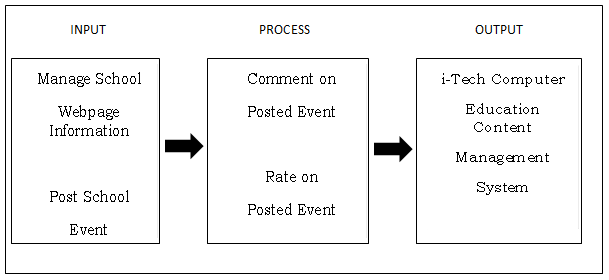
The conceptual framework shows the flow of the system and how it will be processed. It starts when the student/user open the website. They can view the posted events. And they can also rate the posted events based on their satisfaction.
Scope and Delimitation of the Study
This section enumerates the scope covered by the research and its delimitations.
Scope
This covers i-Tech Computer Education Bago City. The focus of this study is to allow the admin to create, add, modify and remove all
posted events; allow the admin view, edit and remove the list of student registered in the website; notify the user for new messages and suggestion of the students; can change the background color of the site; and allow users to rate the posted events.
Delimitation
This study is limited to the office of the i- Tech Computer Education Bago City; the college students of i- Tech computer education Bago City; fresh high school graduate students searching for a school to attend; desktop computers and mobile devices with internet browsers.
Significance of the study
This study will be a significant endeavor in promoting a good quality education. This study will also be beneficial to students and administrator. The proponents aim to produce an online System entitled i-Tech Computer Education Content Management System that allows users to upload pictures to the school album and view their upcoming events and activities, either way, the system is beneficial to:
The Proponents. This study enhances their potential in social and technical capabilities and widens their knowledge by doing various activities, intensive research, and brainstorming needed for the documentation. Each of the proponents does not only share their ideas while doing this study, but the researchers also apply their earned knowledge and learnings from the past.
The Students. They will gain benefits with this system by knowing the current and upcoming events of the institution: likewise, this study also gives them the opportunity to create their own website knowing that i-tech school only rely on Facebook as their database.
The Administrator. This study will be beneficial to the administrator because it will make their task easier, accessible and user-friendly. This will also help the admin to have a site where he/she can have direct access and control.
The Management. This study will give them the opportunity to entertain more upcoming students since their daily business operation are lesser than usual and it will also allow them to disseminate the information and announcements conveniently to their students.
Future researchers. This study will be beneficial to the future researchers because it can be a useful source of information for their CMS study and other similar systems.
Definition of Terms
Activities. Conceptually, it means something that is done for pleasure and that usually involves a group of people (Merriam-Webster’s Learner’s Dictionary).
Operationally, it refers to movement or an action of people. The state of being an active force.
Authentication. Conceptually, it is the process of identifying an individual, usually based on a username and password (webopedia.com).
Operationally, it is credible or authoritative to establish to certify, to give legal force or validity.
Authorize. Conceptually, it means to give power or permission to (someone or something) (Merriam-Webster’s Learner’s Dictionary).
Operationally, it is a permission to access restricted data, application programs, or specific features within an application program.
Competency. Conceptually, it means an ability or skill (Merriam-Webster’s Learner’s Dictionary).
Operationally, it is sufficient for the necessities of life.
Content Management System. Conceptually content management system is software or a group or suite of applications and tools that can seamlessly create, edit, review and publish electronic text (webopedia.com).
Operationally, it is a software that allows admin to change all the content in the system.
Expense. Conceptually it refers to an amount of money that must be spent especially regularly to pay for something. Source: Merriam-Webster’s Learner’s Dictionary
Operationally, it refers to the spending of money, time and etc. the expending of money and other resources.
Innovation. Conceptually it refers to the act or process of introducing new ideas, devices, or methods. Source: Merriam-Webster’s Learner’s Dictionary
Operationally, it refers to the invention of the proponents which is the i- Tech Computer Education Content Management System.
Marketing. Conceptually it refers to the activities that are involved in making people aware of a company’s products, making sure that the products are available to be bought, etc. ( Merriam-Webster’s Learner’s Dictionary).
Operationally, it is a list of product/goods that are available in the company.
Mission. Conceptually it refers to a task or job that someone is given to do. (Merriam-Webster’s Learner’s Dictionary).
Operationally, it is an obligation that is being given to a person.
Netizens. Conceptually, it refers to a person who actively uses the Internet especially in a proper and responsible way (Merriam-Webster’s Learner’s Dictionary).
Operationally, it is referred to people that use internet or social media in a proper way.
Notify. Conceptually it means to tell (someone) officially about something (Merriam-Webster’s Learner’s Dictionary)..
Operationally, it means to give a notice to someone, to inform an information.
Personnel. Conceptually, it refers to the people who work for a particular company or organization (Merriam-Webster’s Learner’s Dictionary).
Operationally, it refers to the persons employed in a business or a group of persons employed as public service, a factory, or an officer.
Promotion. Conceptually, it refers to the act of moving someone to a higher or more important position or rank in an organization (Merriam-Webster’s Learner’s Dictionary).
Operationally, it means to promote persons that capable in higher rank or position.
Records. Conceptually, it refers to write (something) down so that it can be used or seen again in the future: to produce a record of (something) (Merriam-Webster’s Learner’s Dictionary).
Operationally, it refers to an official writing that records and recalls or reports in the past events.
Website. Conceptually it refers to a place on the World Wide Web that contains information about a person, organization, etc., and that
usually consists of many Web pages joined by hyperlinks (Merriam-Webster’s Learner’s Dictionary).
Operationally, it contains all information that usually consists of a web page.
Review of Related Literature and Systems
This chapter shows the summary of the related literature from local to foreign related and how is it used to allocate resources to the user
Review of Related Literature (Local)
DO-CMS
The Dynamic Online Content Management System or DO-CMS is a website management system specifically designed for micro, small and medium-sized enterprises (MSMEs). And designed to be flexible and customizable. It has powered everything from simple 4-page websites to content managed Flash websites, all the way to full-blown e-commerce and multi-domain websites. It is designed to easily accommodate practically any front-end design thus allowing an organization to have full creative control over how its website appears online. (http://web.eacomm.com/17/do-cms)
RapidCMS
RapidCMS is a technology platform from RapidCloud Philippines that functions as a point of access to information in the World Wide Web. A portal presents information from diverse sources in a unified way that enables you to deploy a comprehensive website that caters to specific
industry needs. It provides you with a building platform with rich features that gives you the ability to generate a full-blown web portal for a strong online presence and assist in revenue generation in your business market. RapidCMS is modular, thus making the deployment of your web portal cost-effective, fast & efficient. (rapidcloud.ph/rapidcms.php)
Review of Related Literature (Foreign)
Fooshy CMS
Fooshy is an expandable and flexible content management system aimed at web designers and website owners. Dynamic sites, full of content can quickly and easily be created without the need for any programming skills. Fooshy comes with an easy to use Web Content Administration system with built-in management for documents, images and streamed media, and provides all the components required to build and manage content-rich, attractive websites with the ease of creating a word document. (fooshy.com, 2014)
Word Press
Word Press does not require PHP nor HTML knowledge unlike Drupal, Joomla, or Typo3. A preinstalled plugin and template function allows them to be installed very easily. All you need to do is to choose a plugin or a template and click on it to install. You can easily add fields to forms by yourself or use plugins. It will allow your blog or subpages to have additional labels, categories or descriptions. Word Press menu management has extended functionalities that can be modified to include categories, pages, etc. (wordpress.com, 2015)
Related System
Table 1.0: Related System
| System
Features |
1stLocal Related Study | 2ndLocal Related Study | 1stForeign Related Study | 2ndForeign Related Study | |
| Manage WebPage Information | / | / | / | / | |
| Change the Background Color | O | O | O | O | |
| Manage List
Of Registered Students |
O | O | O | O | |
Table 1 presents show the difference between the features of our system to the local and foreign-related system.
Synthesis
Synthesis presents the relevance of the study that discusses the related literature in connection to our system. The proponents study the related system to determine the difference between the current systems to the related studies. The related system offered a big help to the proponents in making the i-Tech Computer Education Content Management System (CMS). The related system helps the proponents in terms of security of the system.
Methodology
This chapter discusses the methodology used to develop the website, in which the proponents were being guided in establishing the Content Management System. The proponents use the prototyping model which consists of different stages such as; Communication Phase, Quick Planning Phase, modeling Quick Design Phase, Construction of Prototype Phase, Deployment, Delivery, and Feedback Phase.
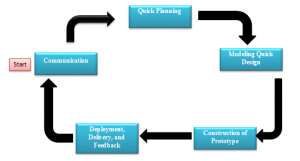
The Prototyping Model is a system’s development method (SDM) in which a prototype (an early approximation of a final system or product) is built, tested, and then reworked as necessary until an acceptable prototype is finally achieved from which the complete system or product can now be developed.
Communication Phase
In this phase, the proponents communicated with the i-Tech Computer Education Director and discussed the problems of the current system to lend help and seek their required features
Quick Planning Phase
The proponents made a quick planning phase to achieve the best system for i-Tech Computer Education, and agreed to have a prototype for testing purposes and reworked until the client satisfaction was achieved.
Modeling Quick design Phase
In this phase, the proponents used the prototyping model to have a quick design for the system.
Construction of Prototype Phase
The proponents agreed to have a prototype to be tested by the administrator and for some selected students of i-Tech Computer Education School and to be reworked if there were important feature that need to be made.
Deployment, Delivery, and Feedback Phase
In this phase the proponents conducted a survey of the students in order to test the system and for them to know if the system will satisfy a client.
User’s Acceptance Survey
The developed website will undergo user acceptance testing by the users of the system: Students and the administration of the school, which includes the office of the Executive Director, and the office clerk of the director’s office.
Cost Benefit Analysis
Table 2.0: Developmental Cost
| Developmental Cost | Duration | Monthly Cost | Total Amount |
| Programmer | 5 months | Php 7,774.00 | Php 38,870.00 |
| System Analyst | 5 months | 8,580.00 | 42,900.00 |
| Project Manager | 5 months | 9,100.00 | 45,500.00 |
| Internet Connection (PLDT) | 5 months | 1,200.00 | 6,000.00 |
| Electricity | 5 months | 250.00 | 1,250.00 |
| Total | Php 134,520.00 |
This table shows the developmental cost of the researched system. The developmental cost includes the proponents’ salary and the expenditures in researching and creation of the researched system.
Table 2.1: Operational Cost
| Operational Cost | Duration | Monthly Cost | Total Amount |
| Electricity | 12 months | Php 250.00 | Php 3,000.00 |
| Maintenance Fee | 12 months | 1,500.00 | 18,000.00 |
| Internet Connection (PLDT) | 12 months | 1,200.00 | 14,400.00 |
| Total | Php 35,400.00 |
This table shows the operational cost of the researched system. The operational cost includes the maintenance cost and expenditures in using the researched system.
Table 2.2: Total Developmental and Operational Cost
| Total Amount | |
| Total Developmental Cost | Php 134,520.00 |
| Total Operational Cost | 35,400.00 |
| Total | Php 169,920.00 |
This table shows the total cost of the development and operation of the researched system.
Table 2.3: Benefits of the System
| Benefits of the System (Annually) | Amount/Value |
| Efficiency of work/output of Employee | Php 61,560.00 |
| Security of Data | 8,000.00 |
| Back up of data | 8,000.00 |
| Work management of Employee | 42,440.00 |
| Total | Php 120,000.00 |
This table shows the computed benefits of the researched system to the school. The proponents have researched on what are the presumed amounts or value of each item that will benefit the school over its traditional method per year.
Table 2.4: Cost Benefit Analysis
| Details | Year 0 | Year 1 | Year 2 | Year 3 | Year 4 | Year 5 |
| 0 | 1 | 2 | 3 | 4 | 5 | |
| Present Value Factor | 1.00 | 0.91 | 0.83 | 0.75 | 0.68 | 0.62 |
| System Cost | 134,520.00 | 35,400.00 | 38,940.00 | 42,834.40 | 47,117.40 | 51,829.14 |
| PV of System Cost | 134,520.00 | 32,214.00 | 32,320.20 | 32,125.50 | 32,039.83 | 32,134.07 |
| System Benefit | 0.00 | 120,000.00 | 132,000.00 | 145,200.00 | 159,720.00 | 175,692.00 |
| PV of System Benefit | 0.00 | 109,200.00 | 109,560.00 | 108,900.00 | 108,609.60 | 108,929.04 |
| NPV | -134,520.00 | 76,986.00 | 77,239.80 | 76,774.50 | 76,569.77 | 76,794.97 |
| Interest Rate | 10% | |||||
| Total PV of System Benefit | 545,198.64 | |||||
| Total PV of System Cost | 295,353.60 | |||||
| Total NPV | 249,845.04 |
YEARS MONTHS DAYS
Payback Period 2.75 1 6 2
Return on Investment 85%
This table shows the cost-benefit analysis of the system. Each figure has corresponding data as shown in the table. The payback period came out as 2.75 with an ROI of 85%.
Data Flow Diagram
This figure shows the data flow of the system. The administrator manages only the Gallery, Events, and Web Content. The student can post a comment and rate the posted events.
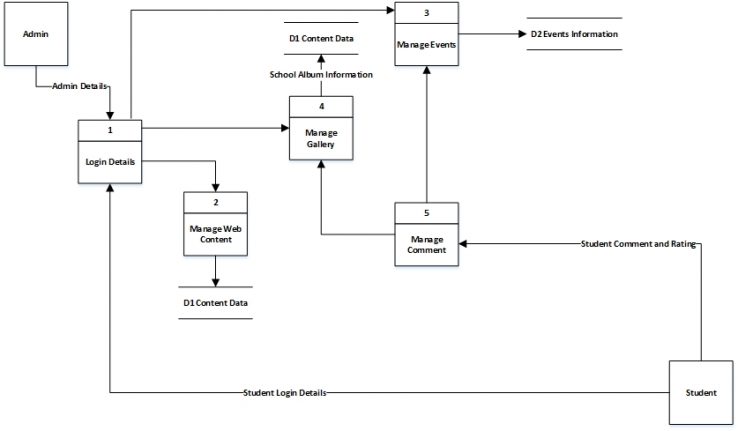
Requirement Specifications
Basically, the goal of the website is to develop the following functionalities:
- This website is an online web-based system that can be accessed anywhere that has internet access.
- This website provides an organized system in which it allows the admin area to post information about the school.
- This website allows the user to rate the pictures that were posted by admin area.
- This website allows the admin area to change the background color of the site according to for their preference.
- An only authorized person can add, edit, and delete information and picture that is posted on the website.
All these functions do not drastically change the current procedural steps; hence problems to its implementation are expected to be minimal.
Program Environment
Front End
The front end is part of a system where the student interacts. It is the part where the student posts a comment and rate the post events. The proponents use PHP for the coding. And CSS for the design.
Back End
The Backend is the server-side of the system where the administrator input the information or the data needed. The proponents use the PHP for the coding and CSS for the design.
Technical Feasibility
Software Specification (Minimum Requirements)
Client:
- Windows 7 Operating System
- Browser ( Mozilla Firefox, Google Chrome )
- Linux
- MySQL server
Server:
- Linux
- Windows 7 Operating System
Hardware Specifications (Minimum Requirements)
Client:
- Dual-Core Processor
- 2GB RAM
Server:
- Processor- Intel Core Processor
- Memory- 4GB DDR3 L Memory
- Drive- 300GB ( IDE or SATA)
- Display- 15’6 AD LED CD (resolution)
- Mouse/Monitor- any compatible
System Architecture
This figure shows the layout of the system. To access the system, the users need an internet and a browser with internet connection.
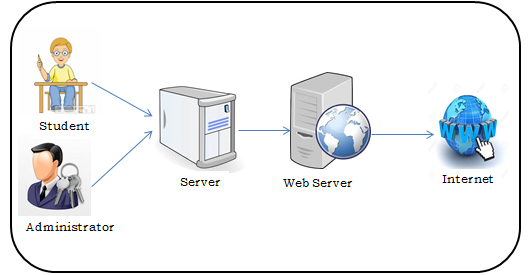
Object Modeling
This figure shows the entities of the system and how it be connected to the entities.
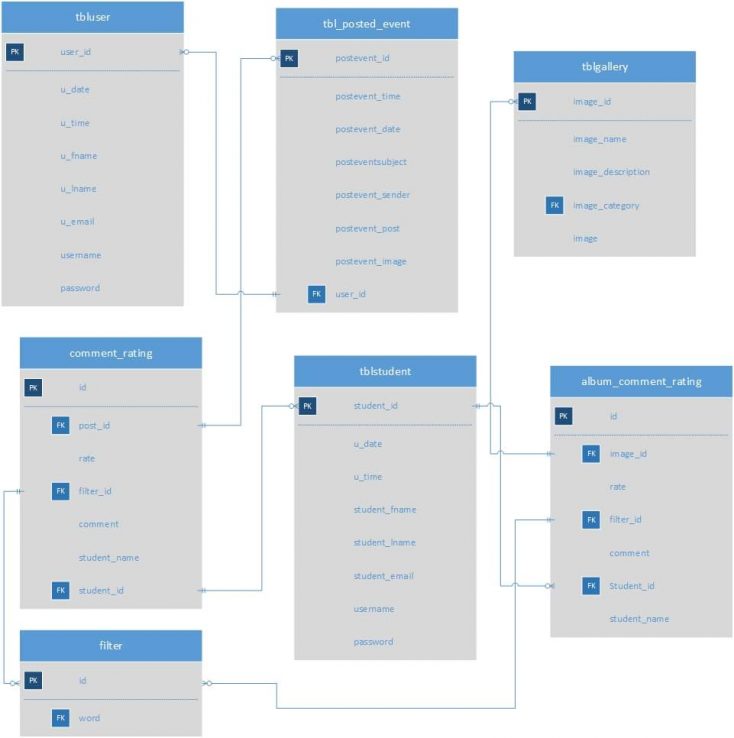
Data Dictionary
Table 3.0: Data Dictionary of the System
Table user
| Field name | Optional | Field type | lenght | Description | ||
| user_id | N | int | (11) | Unique titile | ||
| u_time | N | date | User added time | |||
| u_date | N | time | User added date | |||
| u_fname | N |
|
(50) | User firstname | ||
| u_lname | N |
|
(50) | User lastname | ||
| u_email | N |
|
(50) | User email | ||
| Username | N |
|
(50) | User username | ||
| Password | N |
|
(50) | Username password |
Table posted event
| Field name | Optional | Field type | length | Description | ||
| posted_id | N | int | (9) | Unique title | ||
| posted_time | N | date | Posted time | |||
| posted_date | N | time | Posted date | |||
| postedeventsubject | N |
|
(100) | Posted subject | ||
| Posted_sender | N |
|
(50) | Posted sender | ||
| Posted_post | N |
|
(500) | Posted post | ||
| Posted_image | N |
|
(500) | Posted image | ||
| User_id | N | int | (11) | User id |
Table comment rating
| Field name | Optional | Field type | length | Description | ||
| Id | N | int | (11) | Unique title | ||
| Post-id | N | int | (11) | Posted id | ||
| Rate | N | int | (11) | Rate posted | ||
| Comment | N |
|
Comment posted | |||
| Student_name | N | int | (11) | Student name | ||
| Student_id | N |
|
(50) | Student id |
Table Gallery
| Field name | Optional | Field type | length | Description | |||
| Image_id | N | int | (9) | Unique title | |||
| Image_name | N |
|
(50) | Image name | |||
| Image_description | N |
|
(50) | Image description | |||
| Image_category | N |
|
(50) | Image category | |||
| Student_id | N |
|
(50) | Student id |
Table album comment rating
| Field name | Optional | Field type | length | Description |
| Id | N | int | (11) | Unique title |
| Image_id | N | int | (11) | Posted image id |
| Rate | N | int | (11) | Rate posted events |
| Comment | N |
|
Comments posted events | |||
| Student_id | N | int | (11) | Student id | ||
| Student_name | N |
|
(11) | Student name |
Table student
| Field name | Optional | Field type | length | Description | ||
| student_id | N | int | (11) | Unique id title | ||
| s_date | N | date | Student added date | |||
| s_time | N | time | Student added time | |||
| s_fname | N |
|
(50) | Student added first name | ||
| s_lname | N |
|
(50) | Student lastname | ||
| s_email | N |
|
(50) | Student email | ||
| Username | N |
|
(50) | Student username | ||
| Password | N |
|
(50) | Student password |
Table contact email
| Field name | Optional | Field type | length | Description | ||
| Email_id | N | int | (9) | Unique id title | ||
| N |
|
(100) | Facebook account | |||
| Gmail | N |
|
(50) | Gmail account | ||
| N |
|
(50) | Twitter account |
Table course
| Field name | Optional | Field type | length | Description | ||
| Course_id | N | int | (9) | Unique id title | ||
| Course_name | N |
|
(50) | Course name | ||
| Course_category | N |
|
(50) | Course category | ||
| Course_description | N |
|
(200) | Course description |
This table shows the database of the system. It comprises of the field name, field type, and description.
Presentation, Analysis and Interpretation of Data
This chapter presents the result of the system designed on i-Tech Computer Education Content Management System which will be implemented to i- Tech Computer Education Bago City.
Presentation
The proponents selected the subject to be questioned and demonstrated the system to the subject. The proponents also monitored the subject based on their honesty, interest to the technology, and understanding of the system.
Data Analysis
This section presents the analysis of the data collected from the subject from the students and the administrator of i-Tech Computer Education Bago City.
Characteristics of the Subject
The subject population of the study was composed of the administrator, and students of the i-Tech Computer Education Bago City. The proponents got thirty 30 subject from the i-Tech Computer Education Bago City.
Table 4.0: Frequency of Subjects
| Subjects | Frequency |
| Administrator | 1 |
| Students | 29 |
| Total | 30 |
This table shows the frequency of subjects who have answered the User-Acceptability Survey. The researchers got a total of 30 subjects.
Reliability Testing
The data gathered by the proponents have undergone reliability testing. An acceptable Cronbach’s Alpha of 0.700 is needed in order for the data gathered to be reliable.
Table 5.0: Reliability Test Result
| Cronbach’s Alpha | |
| Acceptable | 0.700 |
| Data Gathered | 0.986 |
This table shows the result of reliability testing undergone by the data gathered from the User-Acceptance Survey. A Cronbach’s Alpha of 0.986 shows that the data gathered is reliable.
Interpretation of Data
The instrument wished to access the perception of the users in terms of five (5) categories namely: Effectiveness, Efficiency, Quality, Timeliness and Productivity. The first category was composed of four (4) items, the second category was composed of three (3) items, and the third, fourth and last categories were composed of four (4) items. The rating scale was 1 to 5 with 1 as very dissatisfied, 2 as dissatisfied, 3 as neutral, 4 as satisfied and 5 as very satisfied.
Table 6.0: Rating Scale
| Range of Mean | Verbal Interpretation |
| 4.21 – 5.00 | Very Satisfied |
| 3.41 – 4.20 | Satisfied |
| 2.61 – 3.40 | Neutral |
| 1.81 – 2.60 | Dissatisfied |
| 1.00 – 1.80 | Very Dissatisfied |
This table shows the range of mean and its verbal interpretation.
Table 7.0 Survey Result
| CATEGORIES | MEAN | RATING |
| Effectiveness | 3.591667 | Satisfied |
| Efficiency | 3.6 | Satisfied
|
| Quality | 3.691667 | Satisfied
|
| Timeliness | 3.666667 | Satisfied
|
| Productivity | 3.611111 | Satisfied
|
The table above shows that the Effective has an average mean weighted as 3.59166 which rated as Satisfied; while the Efficiency get a totaled mean of 3.6 which is rated at the same time as Satisfied. The Quality category got a mean of 3.69166 which interpreted as Satisfied same as in the Timeliness category with an average mean of 3.666667. And lastly under the Productivity category with an average mean of 3.611111 and being rated as Satisfied by the subjects of the survey.
Summary of Findings, Conclusion and Recommendation
This chapter presents the summary of the research work undertaken, the conclusions drawn and the recommendations made as outgrowth of this study.
Summary of Findings
This study was conducted for the purpose of creating a manageable, user-friendly site, entitled i-Tech Computer Education Content Management System. The descriptive method of research was utilized and the survey technique was used for gathering data. The questionnaire served as the instrument for collecting data. The results imply that the proposed website is helpful in terms of giving information and information dissemination to the students of i- Tech Computer Education. The proponents conducted a survey from the i- Tech Computer Education Executive Directors Office and to all the Students enrolled in that institution. The survey was conducted during the school year 2016-2017.
Recommendation
From the findings of this study, the researchers would like to recommend for future proponents to enhance the features of the system. It is also recommended to allow the admin area to change the font style of the site. It is also recommended to create a page within the website wherein it allows the students to have a group chatting within there specific organization. And lastly, the proponents would like to recommend creating a special feature wherein it allows the upcoming students to have an online reservation for enrollment and entrance exam.
Conclusion
The i- Tech Computer Education Content Management System is very helpful to the institution in terms of promoting the school activities to their students using web system. It is also essential to the i- tech school administrator to post pictures and announcements of the current and future events of the school. It is also essential to the students for keeping them aware to the school’s activities and announcements. Therefore, the i- tech administrator should support in developing the online website.

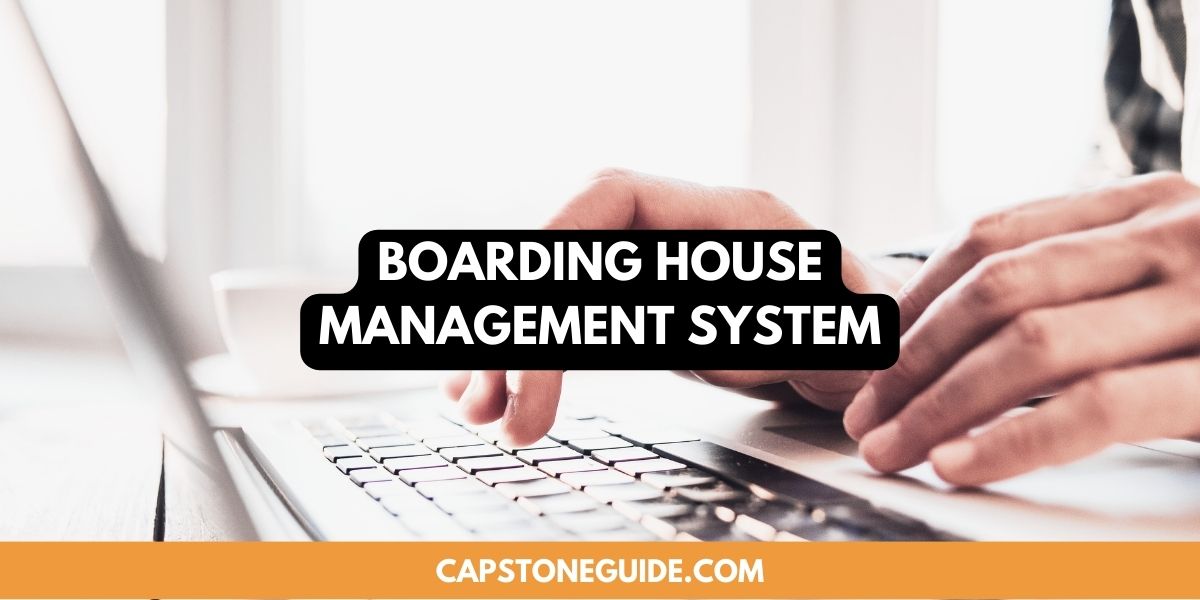


Leave A Comment
You must be logged in to post a comment.